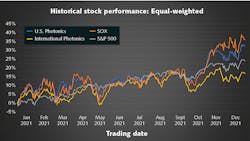The photonics stock indices in 2021: Celebrating the disruptors
The entire photonics community, and in particular in the U.S., owes a debt of gratitude to Kevin Kalkhoven and Valentin Gapontsev, two swashbuckling immigrants from Australia and Russia, respectively, who passed away in recent months. In the late 1990s, they helped open the financial investment floodgates for generations of photonics startups by lighting a fire in front of investors’ eyes and showing that photonics was not just an esoteric little corner of technology serving only absurdly expensive industrial applications and military spook projects. Both of these entrepreneurs charged into the U.S. and then built global companies—and in the process worked hard at showing investors that photonics could create enormous new applications and riches, just as the semiconductor sector had.
I was involved as the lead investment banker taking Uniphase public in 1993. Photonics was hardly a hot market for investors, neither publicly or for VCs. Large and even mid-tier investment banks would not touch it because it didn’t have the metrics, growth, momentum, nor customer base that seemed compelling for large investors, and the products were complex for laymen to grasp. While a few photonics firms like Coherent, Corning, OCLI, II-VI, and Newport were public, they were considered staid industrial firms with low multiples. These were not the firms that the growing hordes of aggressive IT technology and growth investors loved.
As a hired-gun CEO, Kalkoven brought his sales and marketing savvy from the software industry into photonics and drove it into hyper-growth mode through aggressive acquisitions around the world and the hiring of great talent. As Uniphase became JDSU (now Lumentum and Viavi), it overtook much larger, conservative legacy players like Lucent, arming the world with optical communications components and systems to feed the underpinnings of bandwidth hunger and the internet. Investors loved it! This was Disruption 101 at play.
Notably, Uniphase started with very modest capital injections and profit reinvestment, rather than the hundreds of millions of dollars being raised by firms in recent years pursuing disruptive strategies, including the many photonics-based firms addressing the lidar and quantum markets.
Uniphase completed its IPO at $8/share, raising a mere $12 million of fresh capital with a post-money valuation of $32 million on LTM [last twelve months] revenues of $27 million. Hardly a “hot deal”, it traded down and sideways for a year, as its NASDAQ peers rose, until 1995 when its semiconductor inspection business kicked into high gear, and it made its entry acquisition into telecom photonics buying an R&D group at United Technologies that I had introduced to Kevin. It became the first of several bets the company made into the supply chain of wavelength-division multiplexing (WDM) optical systems.
From mid-1994 to mid-1997, the stock price rose 14X, followed by a 50x increase from mid-1997 to its peak in 2000. While it crashed in the dotcom/telecom bust of the early 2000s, it survived games of chicken with competitors. Today, the JDSU offspring of Lumentum and Viavi combined have a market value of approximately $12 billion with solid profitability, and both are critical suppliers to numerous markets including the leading mobile phone makers.
At IPG Photonics, Gapontsev also played the game of disruption aggressively. In his case, vertical integration gave him advantages in costs. Many of the incumbent laser companies behaved like mini-computer vendors had when PCs came on-line, thinking that IPG fiber lasers couldn’t upscale performance to match their gas lasers. I first met Valentin in 1998 at the Uniphase Zurich laser fab grand-opening; he was buying down-binned laser diodes to pump his fiber lasers.
Over dinner in Davos, while still a very small company with no U.S. presence, he laid out his story for growth and vertical integration to a small group of investors, convincing us he was going to win big and take no prisoners. A clearly bold view in the face of much larger incumbents that either dismissed him as not a seriously capable competitor with low-end fiber lasers, or ultimately feared taking him on in the markets where he gained share. Here we are, 20+ years later, with IPG having hit a peak market value of over $10 billion in 2021, surpassing Coherent by far over the past decade as well as Lumentum and II-VI.
The inspirations, histories, and outcomes of Uniphase and IPG played a major role in my creation of the Photonics Stock Indices in 2020. In 1995, VC investors largely ignored photonics investments. However, in 2001, I could find over 100 VCs active in the sector, with approximately 300 VC-backed firms raising over $10 billion by OFC 2000, when JDSU’s market value had reached $125 billion and over 40 brokerage firms covered the stock. After the telecom bust, that coverage shrunk to a handful, and in 2011, I reported to the National Academies Harnessing Light Committee that coverage for the sector became “too thin” to support the desired capital flows into the sector.
The companies in this sector need to continuously benchmark as a group, and for each company to have models to follow and learn from, in the ways that SEMI and the Semiconductor SOX index help the semiconductor sector. Taking in a broad view of the ecosystem rather than just the obvious direct competitors is a useful perspective for all management teams to tap for planning and communications. In 2021, we continued to see the US Photonics Stock Index perform outstandingly well in gaining investor attention, tracking closely with the SOX Index with +35% gains for 2021, outpacing the S&P 500 27% gain and the well-known ARK Innovation ETF, which suffered a 23% loss (see figure).
Of the nearly 100 firms in our U.S. and international indices, nine hit over 100% gains in 2021: Ambarella, Basler, Calix, Camtek, Lasertec, Nova, Onto Innovations, NVIDIA, and On Semi. The mix of top gainers was heavily focused on imaging applications and optical-based semiconductor instrumentation, all of which had outstanding revenue and profit growth. Notably, while not part of the indices because their business is immature, the six lidar firms that went public in 2020-2021 via special-purpose acquisition companies (SPACs) have substantially underperformed for investors, with shares down 50–80% in 2021, and continued to bleed cash from operations. Those firms and their offerings are still in a “show-me” state, not unlike conditions faced by JDSU, IPG Photonics, and other leadership teams in their early days. Investment markets are tough judges—they love inspiring disruptor stories, but at the end of the day need results.
Both Valentin and Kevin innovated as managers and strategists, transforming the photonics sector, bringing in large investment sources, and fostering entrepreneurship that went viral and had lasting impact. Their legacy carries forward. They are among the business leaders who shone a spotlight on the photonics industry and its opportunities, and they executed in their fields to win. We are richer for their drive, resilience, and contributions.
About the Author
John Dexheimer
President, LightWave Advisors
John Dexheimer is President of LightWave Advisors. He has been a past Laser Focus World contributor on business trends and investments in the photonics sector. As an investment banker, he managed the IPO of Uniphase, assisted in their early global acquisitions, and invested in and advised several other optical component firms that have since become part of Lumentum’s global business.

